Effect of Cutting Parameters on Tool Chipping Mechanism and Tool Wear Multi-Patterns in Face Milling Inconel 718
Abstract
:1. Introduction
2. Materials and Experiments
3. Results and Discussion
3.1. Cutting Forces
3.2. Tool Wear Progress and Tool Worn Surface Morphology
3.3. Tool Wear Multi-Patterns
3.4. Tool Edge Chipping Wear Mechanism
3.5. Statistical Analysis
4. Conclusions
- Cutting force and tool wear show a strong linear relationship. The values of the correlation coefficient R between cutting force and tool wear are all above 0.9 under different cutting parameters. The relationship between cutting force and tool wear propagation can be used for milling process planning and for the development of effective tool condition monitoring strategies.
- Mechanical and thermal shocks are the main reasons for tool edge chipping. The dislocations and micro-cracks extend to the tool surface, forming tool edge chipping. The tool edge chipping peels off due to the adhesion and friction of the workpiece material, which damages the tool surface.
- Tool flank wear multi-patterns present different behavior along the cutting edge direction. The adhesion and tool edge chipping on the flank face aggravate the tool wear. Adhesive wear, abrasive wear, diffusion wear, and tool edge chipping occur simultaneously as main wear patterns.
- Cutting parameters have a significant influence on tool wear patterns and tool life. The feed rate has a significant effect on the cutting force, tool life, and tool edge chipping at the 90% confidence level. The cutting speed only has a significant effect on the cutting force at the 90% confidence level.
Author Contributions
Funding
Institutional Review Board Statement
Informed Consent Statement
Data Availability Statement
Conflicts of Interest
References
- Thakur, A.; Gangopadhyay, S. State-of-the-Art in Surface Integrity in Machining of Nickel-Based Super Alloys. Int. J. Mach. Tools Manuf. 2016, 100, 25–54. [Google Scholar] [CrossRef]
- Rahman, M.; Seah, W.K.H.; Teo, T.T. The Machinability of Inconel 718. J. Mater. Process. Technol. 1997, 63, 199–204. [Google Scholar] [CrossRef]
- Ezugwu, E.O.; Bonney, J.; Yamane, Y. An Overview of the Machinability of Aeroengine Alloys. J. Mater. Process. Technol. 2003, 134, 233–253. [Google Scholar] [CrossRef]
- Anand Krishnan, N.; Mathew, J. Studies on Wear Behavior of AlTiN-Coated WC Tool and Machined Surface Quality in Micro Endmilling of Inconel 718. Int. J. Adv. Manuf. Technol. 2020, 110, 291–307. [Google Scholar] [CrossRef]
- Pawade, R.S.; Joshi, S.S. Mechanism of Chip Formation in High-Speed Turning of Inconel 718. Mach. Sci. Technol. 2011, 15, 132–152. [Google Scholar] [CrossRef]
- Liu, C.; Wang, G.F.; Li, Z.M. Incremental Learning for Online Tool Condition Monitoring Using Ellipsoid ARTMAP Network Model. Appl. Soft Comput. 2015, 35, 186–198. [Google Scholar] [CrossRef]
- Bhatt, A.; Attia, H.; Vargas, R.; Thomson, V. Wear Mechanisms of WC Coated and Uncoated Tools in Finish Turning of Inconel 718. Tribol. Int. 2010, 43, 1113–1121. [Google Scholar] [CrossRef]
- Li, Y.; Zou, B.; Shi, Z.; Huang, C.; Li, L.; Liu, H.; Zhu, H.; Yao, P.; Liu, J. Wear Patterns and Mechanisms of Sialon Ceramic End-Milling Tool during High Speed Machining of Nickel-Based Superalloy. Ceram. Int. 2021, 47, 5690–5698. [Google Scholar] [CrossRef]
- Duplak, J.; Duplakova, D.; Hatala, M.; Radchenko, S.; Sukic, E. Surveying the Topography and Examining the Quality of the Machined Surface of Selected Hardened Steels in the Milling Process. J. Eng. Res. 2021, 9, 285–301. [Google Scholar] [CrossRef]
- Thakur, D.G.; Ramamoorthy, B.; Vijayaraghavan, L. Effect of Cutting Parameters on the Degree of Work Hardening and Tool Life during High-Speed Machining of Inconel 718. Int. J. Adv. Manuf. Technol. 2012, 59, 483–489. [Google Scholar] [CrossRef]
- Imran, M.; Mativenga, P.T.; Gholinia, A.; Withers, P.J. Comparison of Tool Wear Mechanisms and Surface Integrity for Dry and Wet Micro-Drilling of Nickel-Base Superalloys. Int. J. Mach. Tools Manuf. 2014, 76, 49–60. [Google Scholar] [CrossRef]
- Hao, Z.; Gao, D.; Fan, Y.; Han, R. New Observations on Tool Wear Mechanism in Dry Machining Inconel718. Int. J. Mach. Tools Manuf. 2011, 51, 973–979. [Google Scholar] [CrossRef]
- Tamil Alagan, N.; Hoier, P.; Zeman, P.; Klement, U.; Beno, T.; Wretland, A. Effects of High-Pressure Cooling in the Flank and Rake Faces of WC Tool on the Tool Wear Mechanism and Process Conditions in Turning of Alloy 718. Wear 2019, 434–435, 102922. [Google Scholar] [CrossRef]
- Pekelharing, A.J. Cutting Tool Damage in Interrupted Cutting. Wear 1980, 62, 37–48. [Google Scholar] [CrossRef]
- De Oliveira, A.J.; Diniz, A.E.; Ursolino, D.J. Hard Turning in Continuous and Interrupted Cut with PCBN and Whisker-Reinforced Cutting Tools. J. Mater. Process. Technol. 2009, 209, 5262–5270. [Google Scholar] [CrossRef]
- Ma, Z.; Xu, X.; Huang, X.; Ming, W.; An, Q.; Chen, M. Cutting Performance and Tool Wear of SiAlON and TiC-Whisker-Reinforced Si3N4 Ceramic Tools in Side Milling Inconel 718. Ceram. Int. 2022, 48, 3096–3108. [Google Scholar] [CrossRef]
- Yu, W.; Ming, W.; An, Q.; Chen, M. Cutting Performance and Wear Mechanism of Honeycomb Ceramic Tools in Interrupted Cutting of Nickel-Based Superalloys. Ceram. Int. 2021, 47, 18075–18083. [Google Scholar] [CrossRef]
- Banda, T.; Ho, K.Y.; Akhavan Farid, A.; Lim, C.S. Characterization of Tool Wear Mechanisms and Failure Modes of TiAlN-NbN Coated Carbide Inserts in Face Milling of Inconel 718. J. Mater. Eng. Perform. 2022, 31, 2309–2320. [Google Scholar] [CrossRef]
- Gassner, M.; Schalk, N.; Tkadletz, M.; Pohler, M.; Czettl, C.; Mitterer, C. Influence of Cutting Speed and Workpiece Material on the Wear Mechanisms of CVD TiCN/Α-Al2O3 Coated Cutting Inserts during Turning. Wear 2018, 398–399, 90–98. [Google Scholar] [CrossRef]
- Zheng, G.; Xu, R.; Cheng, X.; Zhao, G.; Li, L.; Zhao, J. Effect of Cutting Parameters on Wear Behavior of Coated Tool and Surface Roughness in High-Speed Turning of 300M. Measurement 2018, 125, 99–108. [Google Scholar] [CrossRef]
- Li, A.; Zhao, J.; Hou, G. Effect of Cutting Speed on Chip Formation and Wear Mechanisms of Coated Carbide Tools When Ultra-High-Speed Face Milling Titanium Alloy Ti-6Al-4V. Adv. Mech. Eng. 2017, 9, 1–13. [Google Scholar] [CrossRef]
- Jiang, E.; Huang, L.; Jiang, F. Research on the Tool Wear Mechanism of the Wave-Edge End Mill Based on the Tool-Chip Contact Analysis. Int. J. Adv. Manuf. Technol. 2020, 108, 801–808. [Google Scholar] [CrossRef]
- Halim, N.H.A.; Haron, C.H.C.; Ghani, J.A.; Azhar, M.F. Tool Wear and Chip Morphology in High-Speed Milling of Hardened Inconel 718 under Dry and Cryogenic CO 2 Conditions. Wear 2019, 426–427, 1683–1690. [Google Scholar] [CrossRef]
- Li, K.; Zhu, K.; Mei, T. A Generic Instantaneous Undeformed Chip Thickness Model for the Cutting Force Modeling in Micromilling. Int. J. Mach. Tools Manuf. 2016, 105, 23–31. [Google Scholar] [CrossRef]
- Thakur, D.G.; Ramamoorthy, B.; Vijayaraghavan, L. Study on the Machinability Characteristics of Superalloy Inconel 718 during High Speed Turning. Mater. Des. 2009, 30, 1718–1725. [Google Scholar] [CrossRef]
- Li, K.M.; Liang, S.Y. Modeling of Cutting Forces in near Dry Machining under Tool Wear Effect. Int. J. Mach. Tools Manuf. 2007, 47, 1292–1301. [Google Scholar] [CrossRef]
- Zhang, Q.; Yao, J.; Mazumder, J. Laser Direct Metal Deposition Technology and Microstructure and Composition Segregation of Inconel 718 Superalloy. J. Iron Steel Res. Int. 2011, 18, 73–78. [Google Scholar] [CrossRef]
- Xue, C.; Chen, W. Adhering Layer Formation and Its Effect on the Wear of Coated Carbide Tools during Turning of a Nickel-Based Alloy. Wear 2011, 270, 895–902. [Google Scholar] [CrossRef]
- Khochtali, H.; Ayed, Y.; Zemzemi, F.; Bensalem, W. Tool Wear Characteristics in Rough Turning of Inconel 718 with Coated Carbide Tool under Conventional and High-Pressure Coolant Supplies. Int. J. Adv. Manuf. Technol. 2021, 114, 2371–2386. [Google Scholar] [CrossRef]
- Chen, Y.C.; Liao, Y.S. Study on Wear Mechanisms in Drilling of Inconel 718 Superalloy. J. Mater. Process. Technol. 2003, 140, 269–273. [Google Scholar] [CrossRef]
- Peng, R.; Tong, J.; Tang, X.; Chen, R.; Jiang, S. Crack Propagation and Wear Estimation of Ceramic Tool in Cutting Inconel 718 Based on Discrete Element Method. Tribol. Int. 2020, 142, 105998. [Google Scholar] [CrossRef]
- Jun, Z.; Jianxin, D.; Jianhua, Z.; Xing, A. Failure Mechanisms of a Whisker-Reinforced Ceramic Tool When Machining Nickel-Based Alloys. Wear 1997, 208, 220–225. [Google Scholar] [CrossRef]
- Jawaid, A.; Koksal, S.; Sharif, S. Cutting Performance and Wear Characteristics of PVD Coated and Uncoated Carbide Tools in Face Milling Inconel 718 Aerospace Alloy. J. Mater. Process. Technol. 2001, 116, 2–9. [Google Scholar] [CrossRef] [Green Version]

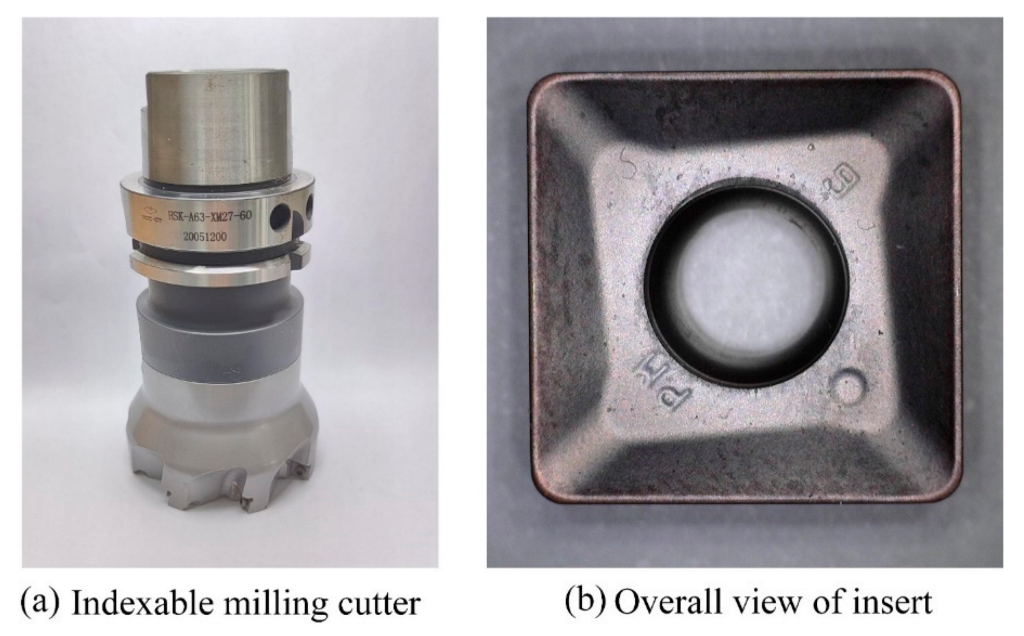
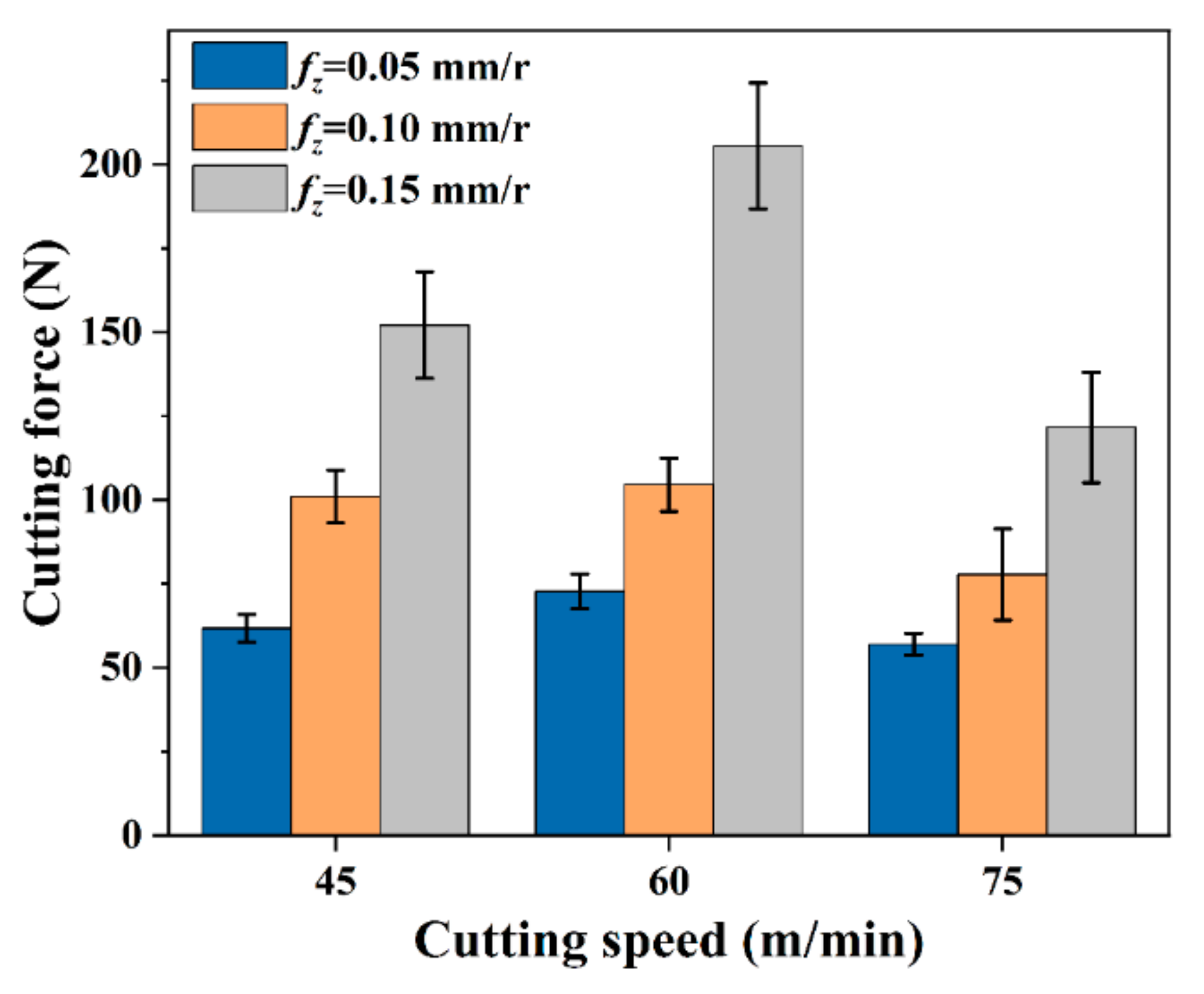

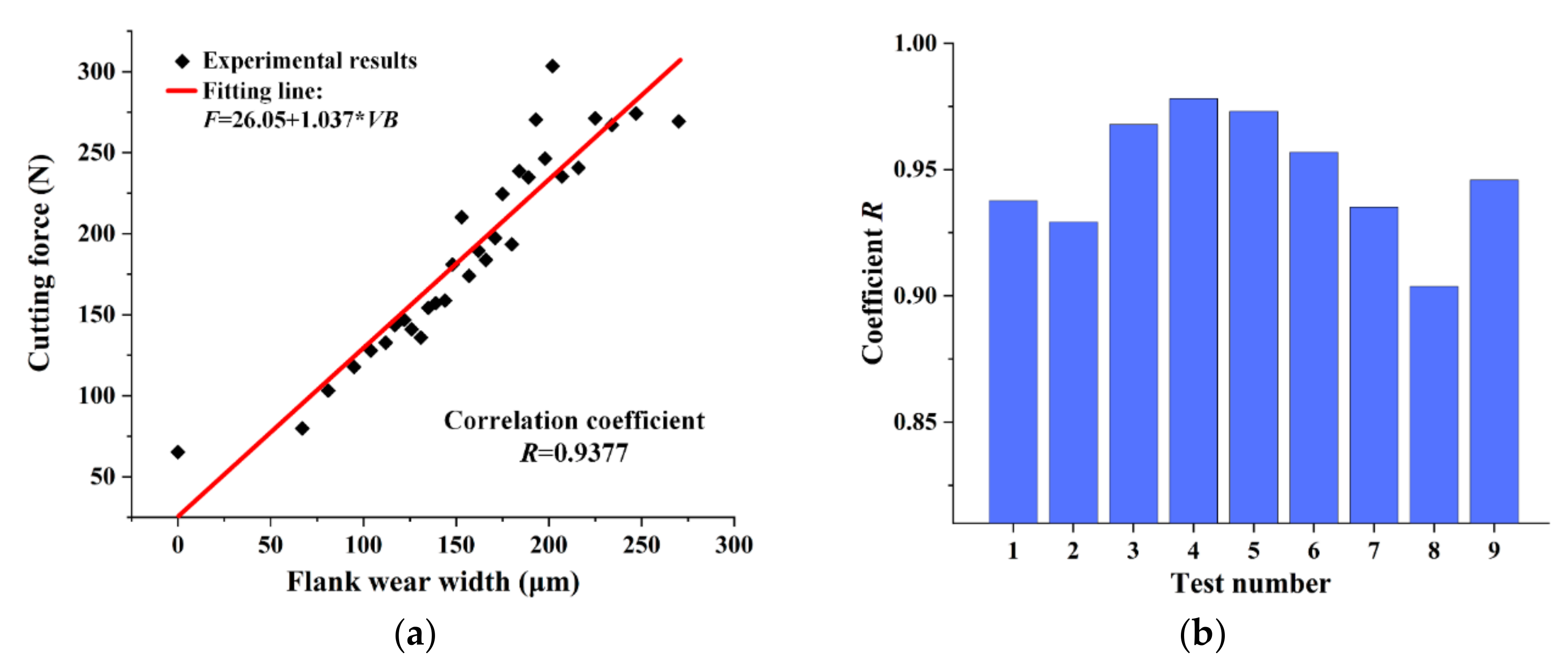

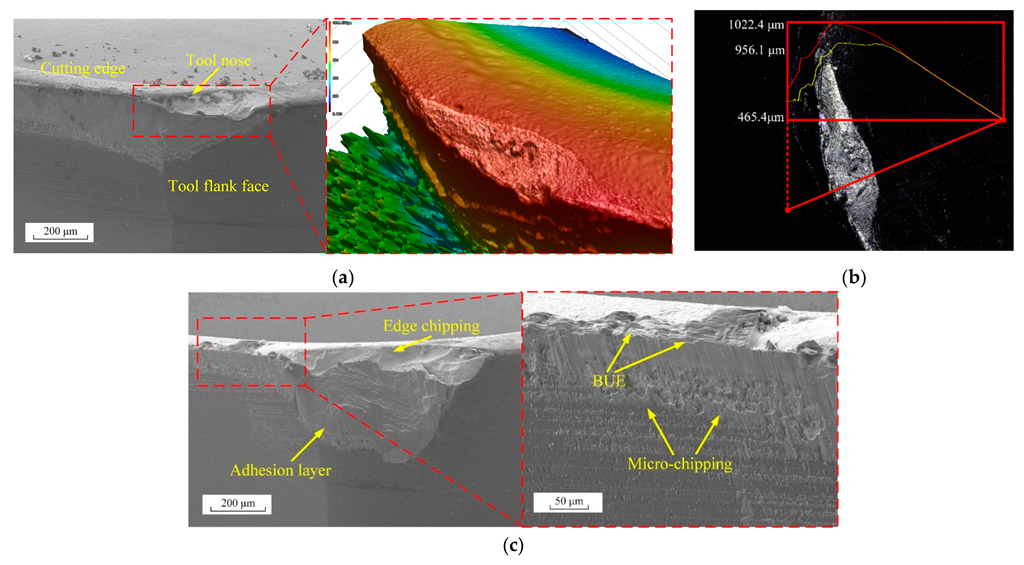


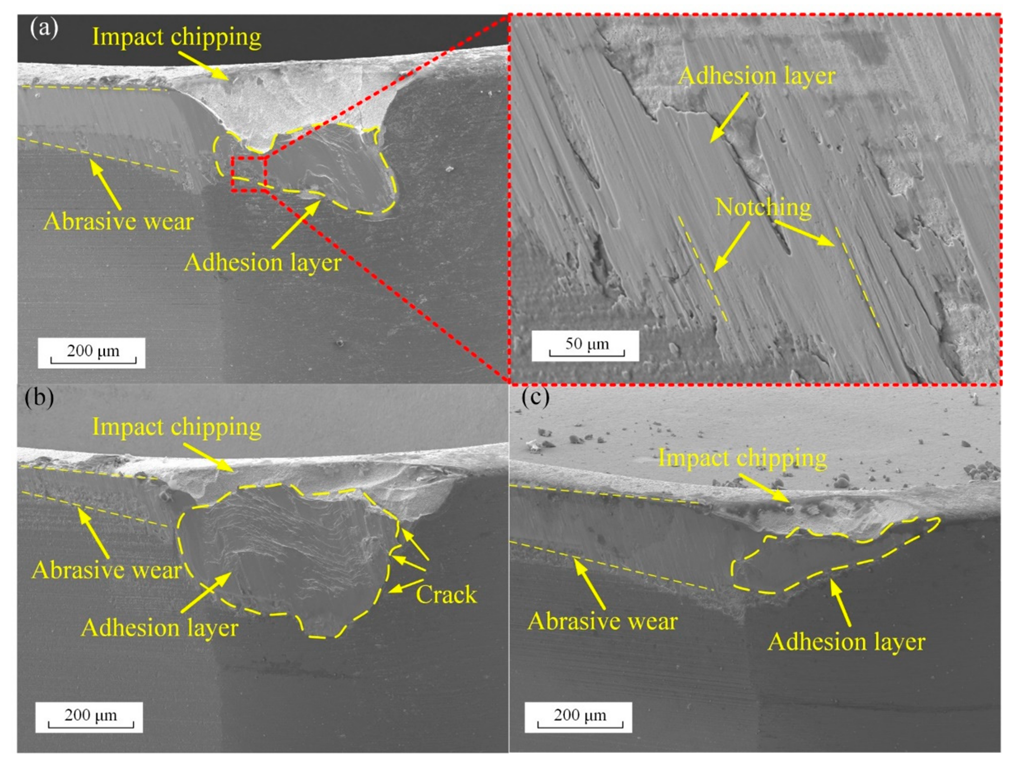
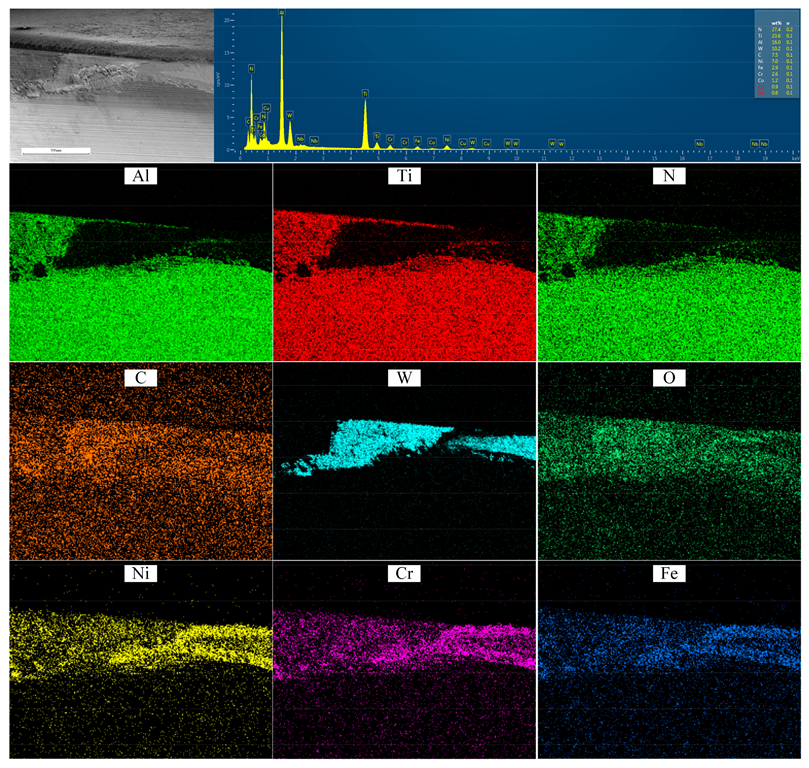

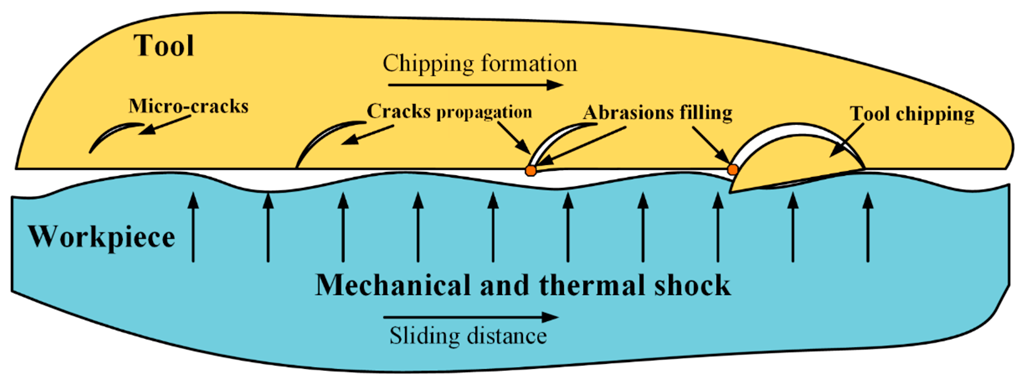
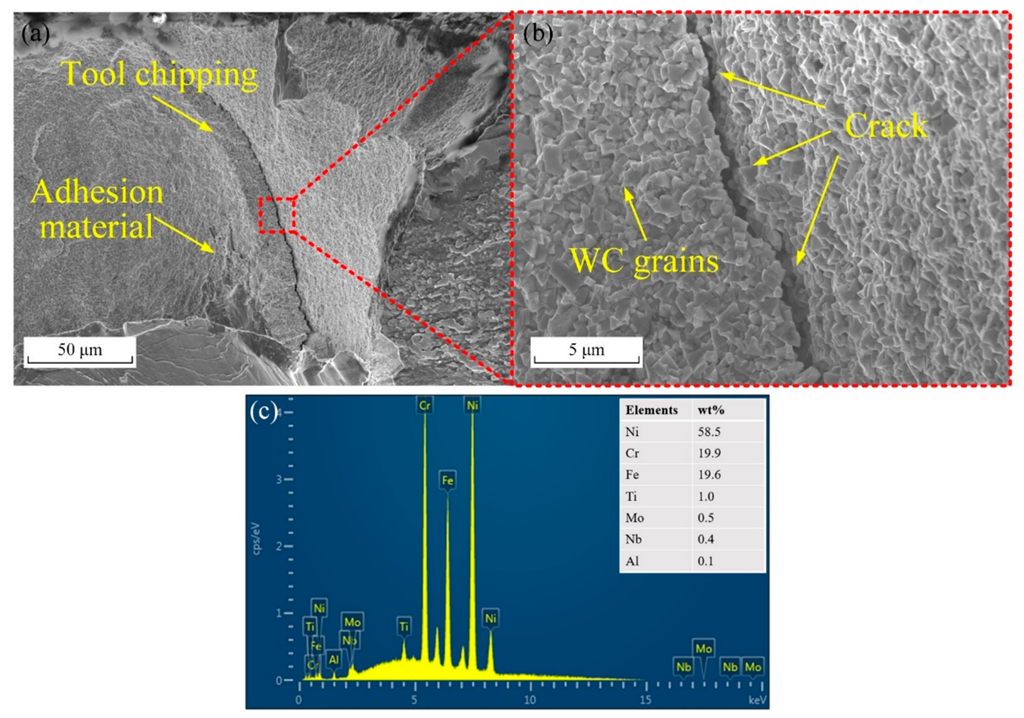
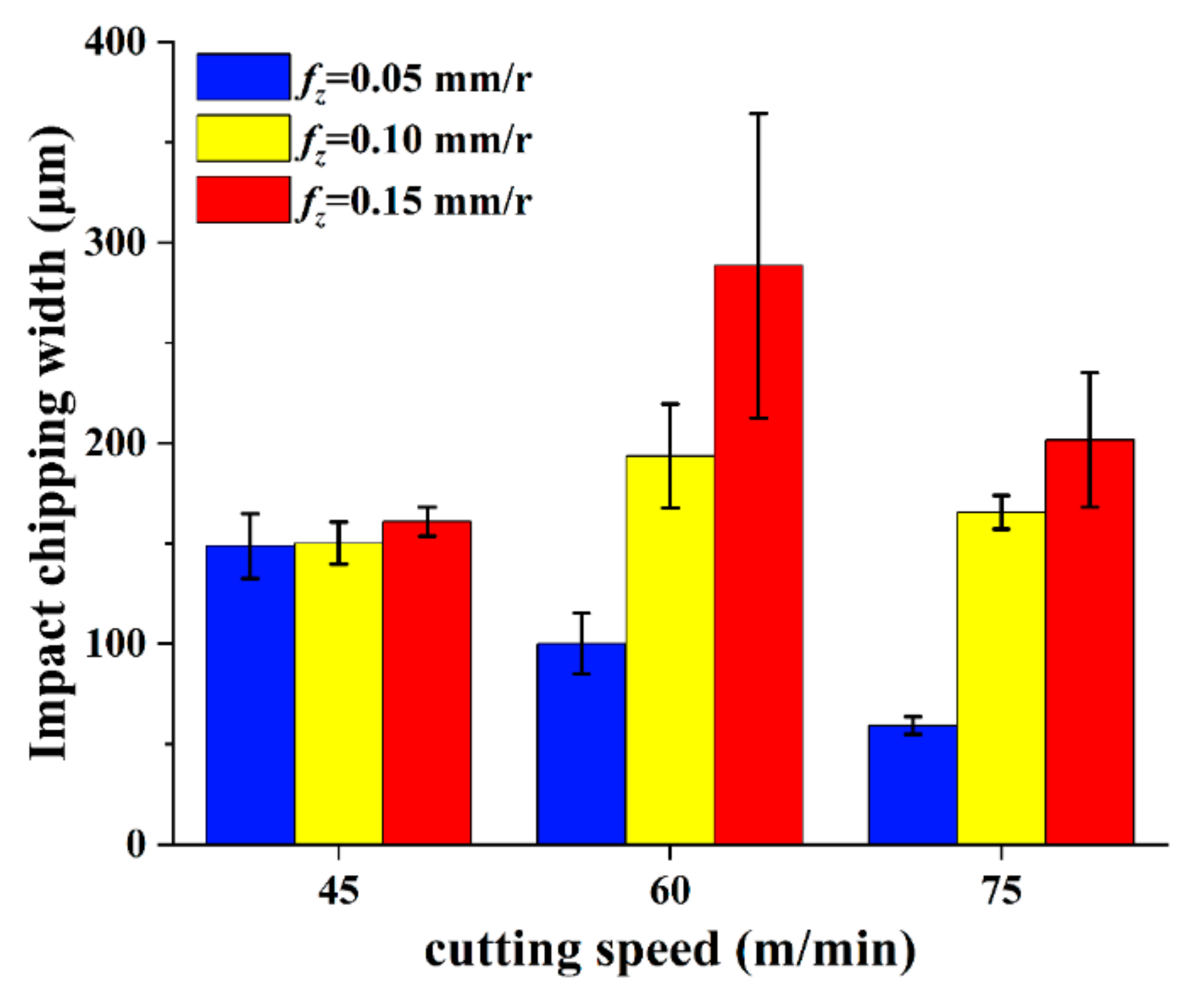
| C | Mn | Cr | Mo | Al | Ti | Co | Nb | Fe | Ni | |
|---|---|---|---|---|---|---|---|---|---|---|
| Wt.% | 2.82 | 0.44 | 17.29 | 3.10 | 0.43 | 0.95 | 0.95 | 5.39 | 17.72 | Bal. |
| Elastic Modulus E (GPa) | Thermal Conductivity K (Wm−1K−1) | Tensile Strength σb (GPa) | Yield Strength σs (GPa) | Hardness H (HV) |
|---|---|---|---|---|
| 199.9 | 19.75 | 1394 | 1179 | 473 |
| Test Group | Cutting Speed vc (m/min) | Feed Rate fz (mm/r) |
|---|---|---|
| 1 | 45 | 0.05 |
| 2 | 60 | 0.05 |
| 3 | 75 | 0.05 |
| 4 | 45 | 0.1 |
| 5 | 60 | 0.1 |
| 6 | 75 | 0.1 |
| 7 | 45 | 0.15 |
| 8 | 60 | 0.15 |
| 9 | 75 | 0.15 |
| Factors | Sum of Squares SS | Degree of Freedom DoF | Mean of Squares MS | F | P | % |
|---|---|---|---|---|---|---|
| Tool life | ||||||
| Feed rate fz | 26.09 | 2 | 13.05 | 6.33 | 0.058 | 61.4 |
| Cutting speed vc | 8.14 | 2 | 4.07 | 1.97 | 0.253 | 19.2 |
| Error | 8.24 | 4 | 2.06 | 19.4 | ||
| Total | 42.47 | 8 | ||||
| Cutting force | ||||||
| Feed rate fz | 16,302.9 | 2 | 8151.5 | 35.49 | 0.003 | 78.0 |
| Cutting speed vc | 3666.9 | 2 | 1833.4 | 7.98 | 0.040 | 17.6 |
| Error | 918.8 | 4 | 229.7 | 4.4 | ||
| Total | 20,888.6 | 8 | ||||
| Tool edge chipping | ||||||
| Feed rate fz | 19,774.8 | 2 | 9887.4 | 4.40 | 0.098 | 59.5 |
| Cutting speed vc | 4487.2 | 2 | 2243.6 | 0.997 | 0.445 | 13.5 |
| Error | 8997.0 | 4 | 2249.3 | 27.0 | ||
| Total | 33,259.0 | 8 |
Publisher’s Note: MDPI stays neutral with regard to jurisdictional claims in published maps and institutional affiliations. |
© 2022 by the authors. Licensee MDPI, Basel, Switzerland. This article is an open access article distributed under the terms and conditions of the Creative Commons Attribution (CC BY) license (https://creativecommons.org/licenses/by/4.0/).
Share and Cite
Liu, D.; Liu, Z.; Wang, B. Effect of Cutting Parameters on Tool Chipping Mechanism and Tool Wear Multi-Patterns in Face Milling Inconel 718. Lubricants 2022, 10, 218. https://doi.org/10.3390/lubricants10090218
Liu D, Liu Z, Wang B. Effect of Cutting Parameters on Tool Chipping Mechanism and Tool Wear Multi-Patterns in Face Milling Inconel 718. Lubricants. 2022; 10(9):218. https://doi.org/10.3390/lubricants10090218
Chicago/Turabian StyleLiu, Delin, Zhanqiang Liu, and Bing Wang. 2022. "Effect of Cutting Parameters on Tool Chipping Mechanism and Tool Wear Multi-Patterns in Face Milling Inconel 718" Lubricants 10, no. 9: 218. https://doi.org/10.3390/lubricants10090218
APA StyleLiu, D., Liu, Z., & Wang, B. (2022). Effect of Cutting Parameters on Tool Chipping Mechanism and Tool Wear Multi-Patterns in Face Milling Inconel 718. Lubricants, 10(9), 218. https://doi.org/10.3390/lubricants10090218








